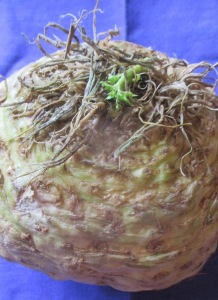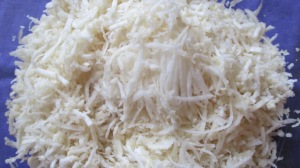
Beautiful in its knobby hairy tentacled-rootletted glory, the celeriac is an autumn root with the flavour of a spring leaf. Ish.
Perhaps you find yourself in its company (a veg box, a farmer’s market) and are unsure what direction to take the conversation? It’s wonderful roasted, in soups and gratins, and alone or mixed with potatoes or other roots in mash. Or, if you’ve read about the collapse of ocean eco-systems, you might want to bookmark the delicious vegetarian kedgeree Anna Jones calls Vegeree.
And of course there’s the famous French salad Celeri Remoulade, which has been inspiring me.
You slice off the gnarled skin (in my case reserving it to add with beetroot to a scrap-filled kvass)…
and grate the celery root (another name for celeriac) with a grater, preferably one with bigger holes so the resulting pieces are neater and less shaggy. This contraption (a mouli julienne) works perfectly, and I seem to see them all the time in charity shops etc. (I love it for all tedious grating, including carrots for salads and potatoes for latkes.)

Ah, a beautiful pile of grated celeriac:
Traditionally, you would just acidulate (keep in lemony water) to protect this vulnerable mass turning an unappealing brown with oxidation. I decided to try fermenting it.
(And in the past, my fermented celeriac did indeed turn brown.)
So I decided to do it differently, and felt my efforts a success.
One celeriac, peeled and grated
a scant measuring-teaspoon of celery salt (sea salt would be fine). Add less if you are salt-conscious. (This is going to be a short ferment.)
juice of one lemon. (This feels important.)
(If you prefer fermenting with whey and are not vegan, this might be a good time to add a little. I didn’t.)
Pack down in a jar, top up with a little water if necessary, wait a few days…

There’s a glass weight in this jar holding down the veg, but impossible to see.
After a few days:

celeriac, lacto-fermenting Day 3
Convinced this was yummy and ready, I consulted the Infinite and Varied Wisdom that is the web, and found so many combinations of how to dress Celeri Remoulade– variations in mayonnaise (homemade, store bought), kinds and quantity of mustard, sometimes a little cream or creme fraiche, and use of fresh herbs like parsley — but why not coriander or mint even? Or nigella seeds, or fresh ginger? So I will leave the dressing to you…
I myself first tried Julia Child’s Celeri-Rave Remoulade [Celery Root in Mustard Sauce] in Mastering the Art of French Cooking — I thought she’d seem definitive to me. In fact her glorious version has no mayonnaise (despite current trends) and so would suit vegans and egg-avoiders alike. I loved making her “sauce,” in fact a very thick vinaigrette:


The beautiful whisk of twigs, gift from my mother-in-law. One of my favourite material possessions.
…and dressed the fermented celeriac with it, but was surprised that I actually yearned a little for the soft creaminess, the mitigation of the sharp, that mayonaise could offer. So I added some; and it was good.
To another little batch of fermenting I added some turmeric and peppercorns, and this also tasted good in a mustardy-mayonaissy dressing. I’m keen to try substituting a miso-mustard I have in this dish. And also trying it really herby, with loads of fresh chopped parsley. Traditional is nice, and playing is nice. But it’s a delicious salad to deliver lots of bacterial goodies.
Kirsten & Christopher Shockey, in their ever inspiring treasure trove Fermented Vegetables, discuss a Naked Celeriac Kraut which is really just grated celeriac and salt. I like the beauty of simplicity in this. And they do a ferment they call “Hungarian Celeriac” with sweet and hot peppers, caraway seed and paprika– next on my list when I find myself with some to use.
Fermented Vegetables also has a version they call Celeriac Remoulade, which takes inspiration from the sauce called remoulade, a kind of cousin. Their version includes chopped pickles and capers– I love the idea of adding those moments of sharp and sour into the creamy mix. (If you’re into fermenting, this is a book you’ll want to have.)
Lots of ideas!
(And the lemon juice is important.)





As soon as I saw the title of this I knew I would want to make it. Now, all I need is some celery root…
You’ll love it! I think you might even like it with the Julia Child “sauce” 🙂
I agree–it sounded great!
[…] on chopping boards; and leeks who ran through streets in mad dreams screaming “celeriac! celeriac!”. who rotted down on compost heaps who sprouted in the supernatural dark of larders, who were […]
I love this recipe, and want to try it. But I have to laugh about the ‘vegeree’. Kedgeree itself is the fishified version of the pure vegetarian khichdi. So instead of going forward to ‘vegeree’ perhaps she could go backward to ‘khichdi’? Or maybe it has changed enough to merit its own name.